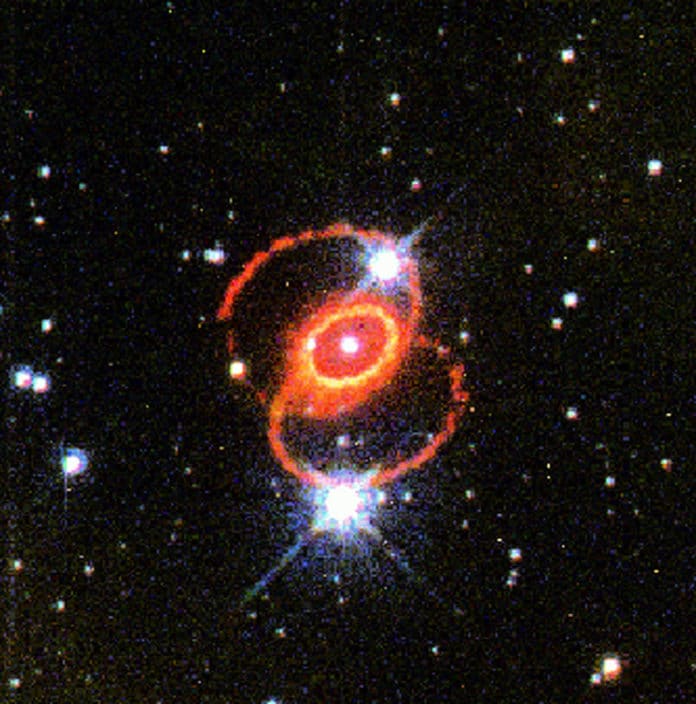Scientists at the Penn State have developed a new technique to measure the temperature of atoms during the explosive death of a star. Scientists combined observations of a nearby supernova remnant — the structure remaining after a star’s explosion — with simulations in order to measure the temperature of slow-moving gas atoms surrounding the star as they are heated by the material propelled outward by the blast.
According to scientists, this method will help them determine the shock wave that occurs as a result of this supernova explosion.
The examination group dissected long term observations of the supernova remnant SN1987A utilizing NASA’s Chandra X-beam Observatory and made a model portraying the supernova. The group affirmed that the temperature of even the heaviest particles — which had not yet been researched — is identified with their atomic weight, noting a long-standing question concerning stun waves and giving essential data about their physical procedures.
David Burrows, professor of astronomy and astrophysics at Penn State said, “Supernova explosions and their remnants provide cosmic laboratories that enable us to explore physics in extreme conditions that cannot be duplicated on Earth. Modern astronomical telescopes and instrumentation, both ground-based and space-based, have allowed us to perform detailed studies of supernova remnants in our galaxy and nearby galaxies.”
“We have performed regular observations of supernova remnant SN1987A using NASA’s Chandra X-ray Observatory, the best X-ray telescope in the world, since shortly after Chandra was launched in 1999, and used simulations to answer longstanding questions about shock waves.”
The explosion of a massive star like SN1987A drives material outwards at rates of up to one-tenth the speed of light, pushing stun waves into the encompassing interstellar gas.
Analysts are especially keen on the shock front, the unexpected change between the supersonic explosion and the moderately moderate moving gas encompassing the star. The stunning front warms this cool ease back moving gas to a large number of degrees — temperatures sufficiently high for the gas to radiate X-rays recognizable from Earth.
Burrows said, “The transition is similar to one observed in a kitchen sink when a high-speed stream of water hits the sink basin, flowing smoothly outward until it abruptly jumps in height and becomes turbulent. Shock fronts have been studied extensively in the Earth’s atmosphere, where they occur over an extremely narrow region. But in space, shock transitions are gradual and may not affect atoms of all elements in the same way.”
Scientists measured the temperatures of different elements behind the shock front, which will improve understanding of the physics of the shock process. These temperatures are expected to be proportional to the elements’ atomic weight, but the temperatures are difficult to measure accurately.
Previous studies have led to conflicting results regarding this relationship, and have failed to include heavy elements with high atomic weights. The research team turned to supernova SN1987A to help address this dilemma.
Supernova SN1987A, which is situated in the nearby star cluster called the Large Magellanic Cloud, was the principal supernova obvious to the stripped eye since Kepler’s Supernova in 1604. It is additionally the first to be considered in detail with modern astronomical instruments. The light from its explosion previously reached Earth on Feb. 23, 1987, and from that point forward it has been seen at all wavelengths of light, from radio waves to X-rays and gamma waves. The exploration group utilized these perceptions to construct a model portraying the supernova.
Models of SN1987A have ordinarily centered around single perceptions, however, in this investigation, the specialists utilized three-dimensional numerical reenactments to join the advancement of the supernova, from its beginning to the present age. An examination of the X-ray perceptions and the model enabled the scientists to precisely gauge nuclear temperatures of various components with a wide scope of nuclear loads and to affirm the relationship that predicts the temperature come to by each kind of molecule in the interstellar gas.
Burrows said, “We can now accurately measure the temperatures of elements as heavy as silicon and iron, and have shown that they indeed do follow the relationship that the temperature of each element is proportional to the atomic weight of that element. This result settles an important issue in the understanding of astrophysical shock waves and improves our understanding of the shock process.”
A paper describing the results appears Jan. 21 in the journal Nature Astronomy.
